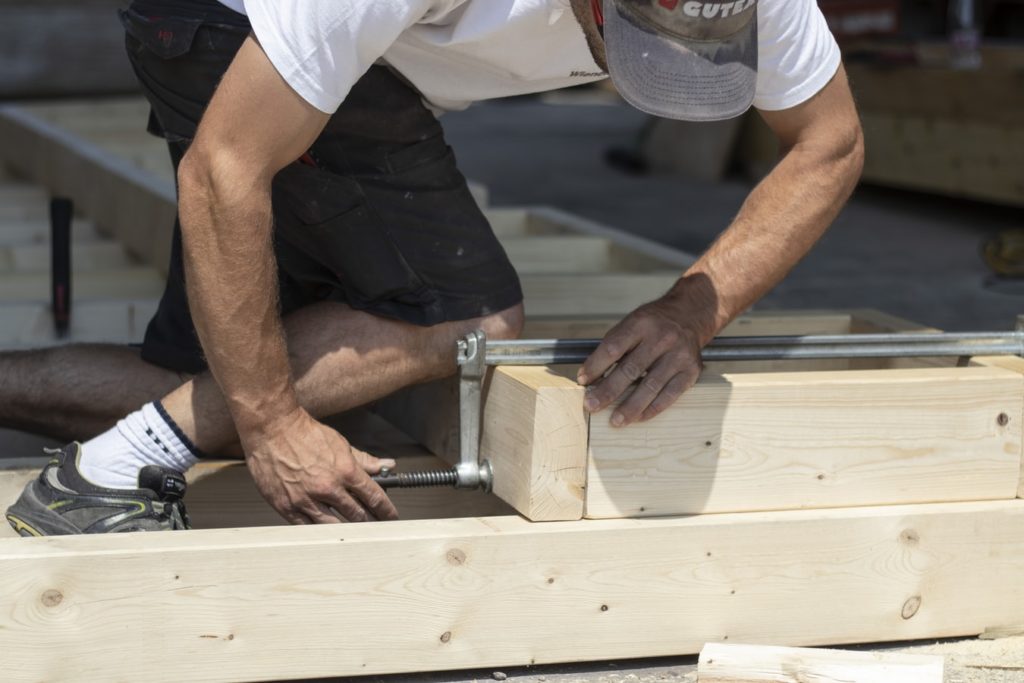Carpenters build, install, shape and repair structures made from wood and other materials. A skilled carpenter can work on construction projects almost anywhere, from erecting skyscrapers to crafting kitchen cabinets.

Artistry is involved in shaping and joining pieces of wood. You’ll develop skill with a variety of hand tools and power equipment that can be used to sculpt wood into functional structures and beautiful objects. Good math skills are also required to produce that artistry. Precision is an essential component of carpentry. If your math is off by even a fraction of an inch, that’s still a gap too far.
One of the pleasures of carpentry is you get to decide what type of work you want to do. Will you be a generalist or will you specialize in a single, highly-skilled aspect of the craft? If you work for a construction company, that choice might be made for you. You might be put in charge of scaffolding construction on a big job site. After a while, if scaffolding is all you do, it might be time to think about broadening your career prospects.
Some carpenters go into business for themselves and are then able to decide precisely which projects they want to tackle.
The process of becoming a carpenter is not long, but can be time consuming. An apprenticeship might last 4 years, but the skills you’ll acquire will last a lifetime.
If you’re ready to use your creativity and artistic skills in pursuit of a career that lets you work with your hands, read on to learn what it takes to become a carpenter.
In this article you’ll learn:
- How much money you can make as a carpenter
- The required training and certifications
- Professional groups to join
- Employment opportunities for carpenters
- Finding clients
- Plus helpful tips
How much money can you make?
The average carpenter salary in the United States is $56,299 as of 2020, according to Salary.com. That works out to $29.32 per hour. Salary ranges vary depending on experience, education, certifications, and additional skills. Self-employed carpenters typically earn much more, with an annual income in the six-figure range not uncommon.
Training and Certification
Some carpenters start training for the craft in high school. Beyond general shop class, courses in math, mechanical drawing and blueprint reading will help prepare students for a carpentry career.
Following high school, some beginning carpenters may find work as an assistant or secure an apprenticeship with an experienced professional who provides training and pays a salary to the apprentice. New carpenters might pursue this path in tandem with a trade or post-secondary vocational school, or coursework at a community college.

Apprenticeship rules vary by state. In most cases, the apprentice must be at least 18 and complete 3-4 years of on-the-job training.
Whether you work as an apprentice or pursue traditional classroom training, you’ll learn basic structural design and common carpentry projects. These include rough framing, and outside and inside finishing, including custom carpentry such as cabinetry. You’ll also learn the proper and safe use of carpentry tools and equipment, how to read blueprints and use math to produce accurate work, as well as job safety and first aid.
Skills that you will develop mainly with practice include good eye-hand coordination, manual dexterity, balance and physical fitness.
Good training programs will deliver plenty of opportunities for hands-on practice as well as classroom instruction. Be sure to choose a training program approved by the state where you plan to become licensed. Different states have different requirements for training, certification and licensure.
Here is an extensive list of carpentry schools and training programs you can review to find the best fit for your needs.
This state by state guide to licensing requirements for a carpenter will help you know what you need to do to qualify for licensure in your area.
Professional Groups to Join
The United Brotherhood of Carpenters
The United Brotherhood of Carpenters and Joiners of America leads the way in training, educating, and representing the next generation of skilled construction professionals. We equip our professional craftsmen with skills that are demanded in today’s construction industry. Join by contacting the nearest UBC Council.
Additionally, there are many regional associations devoted to the carpentry profession. Depending on where you live, joining one or more of these could open doors to many networking opportunities. An extensive listing of carpentry associations can be reviewed here.
Employment
When you’re just starting out as a carpenter, you may not be ready to start your own business. Insurance, renting office space, buying tools, equipment and a truck to haul it all around – these things add up quickly. As an alternative, you can hone your skills working for a construction or carpentry company.
Search online sites such as Indeed and ZipRecruiter to find local jobs. Send or hand-deliver your resume, copies of your certifications, references and printed photos of your past projects to carpentry and construction companies in your area. Always follow up with a phone call.

Finding Clients
When you decide to pursue the dream of self-employment as a carpenter, finding steady work is your responsibility. This means doing your own marketing, getting your name out there.
You’ll need a website. Nothing fancy, just a page outlining your services and contact information, and a few pages of photos showing off your carpentry. Some “before” and “after” photos make a nice contrast to illustrate the benefits customers enjoy when hiring you for the job.
Next, order business cards printed with your company name, phone number and website address. If there’s room for a slogan or catchy motto, add that, too.
Small, independent hardware stores may be willing for you to post a flyer for your business in the store window.
As your cash flow improves and becomes consistent you can consider buying advertising. Until then, take advantage of the many online sites that allow you to search for and bid on carpentry jobs.
Customer retention is also important. Keep your customers happy and you’ll enjoy repeat business for years to come. People almost always stick with companies they trust, but a reliable carpenter is gold.
As an incentive, offer your regular customers a discount for referring new customers, then give new customers a discount.

Good to know
- Basic tool kit for new carpenters: hand saw, jig saw, circular saw, claw hammer, screwdrivers (see below) tape measure, chisel, jack plane, power drill and set of drill bits, nail set, spirit level, block plane, layout square, utility knife, router, sander and sanding sheets, safety goggles for eye protection and a lockable toolbox large enough to hold all hand tools.
- As with virtually all construction jobs, carpentry is hard, physical work. You’ll want to be in good shape and stay that way to perform at peak efficiency. Expect to be standing, climbing, bending, and kneeling all day. The job itself may keep you physically fit, but a regular regimen of flexibility exercises can help.
- Working with power tools or even just a claw hammer and sack of nails will pose a risk of injury, so safety is always going to be an important part of a successful project. Don’t put yourself in any situation where the job site or the tools available to do the job are not up to safety standards.
- Don’t rely exclusively on your tape measure. Use a pencil to mark wood precisely.
- A smooth-head, flat-claw hammer will be more versatile than any other hammer you can buy.
- Before investing in a set of 100+ screwdrivers, see how long you can get by with a couple of flat-blade screwdrivers and a #2 Phillips-head screwdriver. The #2 Phillips will fit 90 percent of the screws you’ll typically need to twist into place.
- Ordering slightly more material than you estimate you’ll need for a job, even if you end up with leftovers, will almost always be less expensive than not ordering enough, which means you have to stop work and go back to the supply store for more.
- Buy a tool belt that will outlast you. Cheap belts get replaced year after year. You’ll just be losing money. Leather offers a good blend of durability and strength to hold your valuable tools securely.
If you enjoyed this article, check out some more great PocketSuite.io content that can help you grow your career as a carpenter. Here’s a great place to start.PocketSuite has thousands of business owners who all started where you are right now. Our community is always happy to help you ramp up, grow your client base, and achieve your income goals, both within the PocketSuite app and as part of our exclusive Facebook Community Group. PocketSuite’s vision is for any professional to be able to work for themselves and make a great living. It starts here. It starts with you. It starts today. Let’s get started, download PocketSuite now! Feel free to reach out with any questions (we’d love to hear from you)! Text us @ (415) 841-2300.





